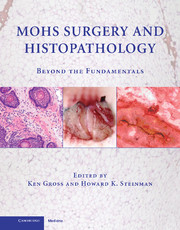Book contents
- Frontmatter
- Contents
- CONTRIBUTORS
- MOHS SURGERY AND HISTOPATHOLOGY
- PART I MICROSCOPY AND TISSUE PREPARATION
- PART II INTRODUCTION TO LABORATORY TECHNIQUES
- Chap. 6 LAB PEARLS: MAKING GREAT SLIDES
- Chap. 7 LAB PEARLS: STAINING, INKING, AND COVERSLIPPING
- Chap. 8 LAB PEARLS: TROUBLESHOOTING SLIDE QUALITY
- Chap. 9 MOHS SLIDES ORGANIZATION AND STANDARDIZATION FOR EFFECTIVE INTERPRETATION
- Chap. 10 MOHS MAPPING
- PART III MICROANATOMY AND NEOPLASTIC DISEASE
- PART IV SPECIAL TECHNIQUES AND STAINS
- INDEX
Chap. 9 - MOHS SLIDES ORGANIZATION AND STANDARDIZATION FOR EFFECTIVE INTERPRETATION
from PART II - INTRODUCTION TO LABORATORY TECHNIQUES
Published online by Cambridge University Press: 03 March 2010
- Frontmatter
- Contents
- CONTRIBUTORS
- MOHS SURGERY AND HISTOPATHOLOGY
- PART I MICROSCOPY AND TISSUE PREPARATION
- PART II INTRODUCTION TO LABORATORY TECHNIQUES
- Chap. 6 LAB PEARLS: MAKING GREAT SLIDES
- Chap. 7 LAB PEARLS: STAINING, INKING, AND COVERSLIPPING
- Chap. 8 LAB PEARLS: TROUBLESHOOTING SLIDE QUALITY
- Chap. 9 MOHS SLIDES ORGANIZATION AND STANDARDIZATION FOR EFFECTIVE INTERPRETATION
- Chap. 10 MOHS MAPPING
- PART III MICROANATOMY AND NEOPLASTIC DISEASE
- PART IV SPECIAL TECHNIQUES AND STAINS
- INDEX
Summary
MOHS SURGEONS often do multiple cancer excisions concomitantly. This may involve multiple patients and sometimes multiple sites on these patients. Organization is the way the Mohs surgeon-pathologist approaches and optimizes the excision of the cancer, processes and interprets the tissue margins, and translates these findings back to the patient's surgical wound in an efficient manner. Standardization allows the Mohs method to be reproducible and reliably accurate.
SLIDE ORGANIZATION
When performing multiple simultaneous Mohs surgeries for skin cancer, the Mohs surgeon-pathologist must have the slides organized in a way that ensures that the correct patient's slides are being read from the deepest wafers (closest to the true margin) to the shallowest wafers (deepest into the block); that each stage is clearly differentiated from the preceding and following stages; that the chromacoding is accurately done and interpretable on the slides; that multiple tumors on the same patient can be distinguished; and that the pathologic findings can be related to the patient's defect(s).
EVALUATING AND INTERPRETING MOHS SLIDES EFFECTIVELY
Over the course of hours, the Mohs technician should produce high-quality slides that will demonstrate approximately 100% of the true margins of the excised tissue. Before attempting to interpret these slides, the Mohs surgeon-pathologist should follow several steps:
The microscope should be set up for optimal performance (see Chapter 3).
The biopsy slides for each patient and cancer site should be at the microscope along with the Mohs frozen section slides for each site.
[…]
Information
- Type
- Chapter
- Information
- Mohs Surgery and HistopathologyBeyond the Fundamentals, pp. 67 - 77Publisher: Cambridge University PressPrint publication year: 2009
